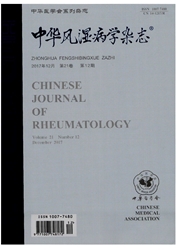

 中文摘要:
中文摘要:
目的分析SLE患者调节性T细胞中微小RNA(miR)-326mRNA的表达水平与SLE临床特征之间的关联,探讨调节性T细胞中miR-326在SLE发病中的作用。方法收集52例SLE患者和20名健康对照者的资料,并采集抗凝静脉血20ml。磁珠分选法分选调节性T细胞,实时荧光定量PCR技术检测调节性T细胞中miR-326的表达水平。采用秩和检验及Spearman相关分析进行统计学分析。结果SLE组调节性T细胞中miR-326mRNA的表达水平[2.927(0,518,8.662)]高于健康对照组[0.921(0.345,1.879)](Z=-3.756,P〈0.05);新发SLE组及复发SLE组miR-326mRNA的表达水平分别为[8.878(5.922,12.466)]和[3.512(0.582,11.223)],显著高于健康对照组(z=-2.135,Z=-4.928,P均〈0.05)。新发SLE组miR.326的表达水平高于稳定SLE组[1.178(0.508,3.211)](Z=-4.928,P〈0.05)。在有浆膜腔积液的新发SLE患者的调节性T细胞中miR.326mRNA的表达水平[7.606(0.656,16.795)]高于无浆膜腔积液的患者[1.840(0.576,13.025)](Z=4.263,P〈0.05)。新发SLE组患者调节性T细胞中miR.326mRNA表达水平与抗C1q抗体(仁0.729,P〈0.05)及CRP(rs=0.481,P〈0.05)水平呈正相关。结论miR.326mRNA在新发SLE患者调节性T细胞中显著升高,并与部分疾病活动指标相关,提示调节性T细胞中miR.326可能与早期SLE的疾病发生及活动相关。
 英文摘要:
英文摘要:
Objective To analyze the association of miR-326 mRNA expression level on regulatory T cells between clinical manifestations of patients with systemic lupus erythematosus (SLE), in order to inves-tigate the role of miR-326 on Treg cells and pathogenesis as well as its association with disease activity of SLE. Methods Twenty milimeter anti-coagulated peripheral blood was obtained from 52 SLE patients and 20 healthy controls. Treg were purified by MACS from peripheral blood, in which the quantity of miR-326 and Ets-1 mRNA were assessed by real-time polymerase chain reaction (PCR). Data were analyzed by using Mann- Whitney U test and Spearman correlation analysis. Results Compared with healthy controls [0.921 (0.345, 1.879)], the expression of miR-326 mRNA level was significantly higher in Treg from SLE patients [2.927 (0.518, 8.662) (Z=-3.756,P〈0.05). The difference between new-onset SLE patients [8.878(5.922, 12.466)] and recurrence group [3.512(0.582, 11.223)] with healthy controls was significant (Z=-2.135, Z=-4.928, P〈0.05). The expression level of miR-326 in new-onset SLE patients was higher than inactive SLE patients (Z=-4.928, P〈0.05). Significant difference of the expression level of miR-326 mRNA was found between new-onset SLE patients with serous cavity effusion [7.606(0.656, 16.795)] and new-onset SLE patients without it [1.840(0.576, 13.025)] (Z=4.263, P〈0.05). Our analysis showed that significant positive correlation was found between the expression of miR-326 mRNA in Treg with CRP (rs=0.481, P〈0.05) and anti-Clq antibody (rs=0.729, P〈0.05) from new-onset SLE patients. Conclusion The expression level of miR-326 is upregulated in Treg from SLE patients and is associated with disease active index, which suggests that miR-326 in Treg may participate the pathological process and disease activity in SLE.
 同期刊论文项目
同期刊论文项目
 同项目期刊论文
同项目期刊论文
 期刊信息
期刊信息
